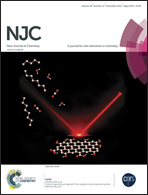Preparation of multicolor emitting carbon dots for HeLa cell imaging
Abstract
We have synthesized biocompatible fluorescent carbon dots (CDs) by a one-step hydrothermal method using Solanum tuberosum (potato) as a raw material. The CDs were characterized by UV-visible, fluorescence, Fourier transform infrared (FT-IR), X-ray diffraction (XRD), thermogravimetric analysis (TGA), dynamic light scattering (DLS) and high-resolution transmission electron microscopic (HR-TEM) techniques. We found that the carbonization of potato at ∼170 °C for 12 h produces highly fluorescent CDs of 0.2–2.2 nm size. The synthesized CDs are well dispersed in water and exhibited strong blue and bright blue emissions under UV illumination (λex = 302, 365 nm). The CDs showed a strong emission peak at 455 nm at an excitation wavelength of 374 nm. The CDs acted as fluorescent probes for multicolor (blue, green and red) imaging of HeLa cells and the CDs did not induce cell death, which indicates that the CDs are biocompatible and nontoxic to HeLa cells. Therefore, the CDs can be used as probes for cell-imaging applications in vitro and in vivo.


 Please wait while we load your content...
Please wait while we load your content...